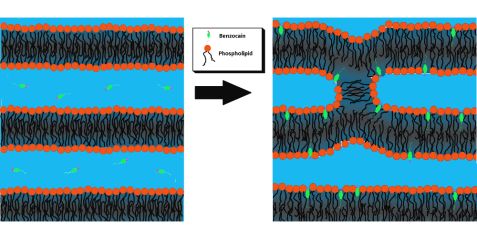MLZ is a cooperation between:
 > Technische Universität München
> Technische Universität München > Helmholtz-Zentrum Hereon
> Helmholtz-Zentrum Hereon
 > Forschungszentrum Jülich
> Forschungszentrum Jülich
MLZ is a member of:
 > LENS
> LENS > ERF-AISBL
> ERF-AISBL
MLZ on social media:

MLZ (eng)
Lichtenbergstr.1
85748 Garching
28.11.2017
New method for drug research: Detecting Membrane Changes Using Neutrons

Common membrane-active substances such as benzocaine (green) embed themselves into lipid bilayers and alter their structure. Neutron investigations are ideally suited for demonstrating such changes. © Forschungszentrum Jülich
Drugs can alter the structure of cell membranes. This in turn can affect their function and cause undesirable side effects. The structural changes in cell membranes caused by drugs have not yet been sufficiently investigated. Researchers from Jülich, Garching (near Munich), Georgia, and France now want to change this. They have developed a new neutron research method which enables deformations of the membranes to be detected faster and more easily than previous methods.
Cell membranes envelop the cells in the human body like a protective layer of skin. They are very thin – 10,000 times thinner than a human hair. Their basis forms a double layer of partly water-repellent molecules known as lipids. Lipids contain various protein molecules, which form passages, for example, to import nutrients and chemical messengers inside the cell or to release metabolic waste products. These passages are often the point of application for drugs.
For their investigations, scientists from Forschungszentrum Jülich, Heinz-Maier-Leibnitz Zentrum in Garching, Tbilisi State University in Georgia, and Laboratoire Léon Brillouin in Saclay (France) used a bilayer of soy lipids as a model system. The latter does not contain any embedded proteins but is otherwise very similar to the membranes of cells. A major advantage of this method is that it is easier to detect structural changes to the lipid film, which forms very evenly. Furthermore, the researchers were able to deposit these lipid layers on a flat surface for measurements, which also facilitated the interpretation.
In order to test their method, the researchers investigated how two widely used drugs impact on the structure of the membrane. They were thus able to demonstrate how the local anaesthetic benzocaine and the beta blocker propranolol either cause the model membranes to stiffen and become fragile or allow the formation of stalks between the two layers of the membrane. “Both effects are undesirable in physiological terms and could cause side effects in the event of an overdosage or the long-term intake of drugs,” suspects Dr. Henrich Frielinghaus, who is responsible for the small-angle scattering diffractometer KWS-1 operated by the Jülich Centre for Neutron Science (JCNS) at the Heinz-Maier-Leibnitz Zentrum in Garching. Such hypotheses cannot be proven directly using the new method. “The fundamental effect of the substances on the membranes can be clearly detected, however. Our neutron investigations can thus indicate whether further tests are worthwhile,” Frielinghaus explains. The researchers can analyse test around ten substances per day.
Text: Angela Wenzik / FZ Jülich
Original publication:
G. Mangiapia, M. Gvaramia, L. Kuhrts, J. Teixeira, A. Koutsioubas, O. Soltwedel and H. Frielinghaus; Effect of Benzocaine and Propranolol on phospholipid-based bi-layers;
Phys. Chem. Chem. Phys. 2017, DOI: 10.1039/C7CP06077G
MLZ is a cooperation between:
 > Technische Universität München
> Technische Universität München > Helmholtz-Zentrum Hereon
> Helmholtz-Zentrum Hereon
 > Forschungszentrum Jülich
> Forschungszentrum Jülich
MLZ is a member of:
 > LENS
> LENS > ERF-AISBL
> ERF-AISBL
MLZ on social media:


